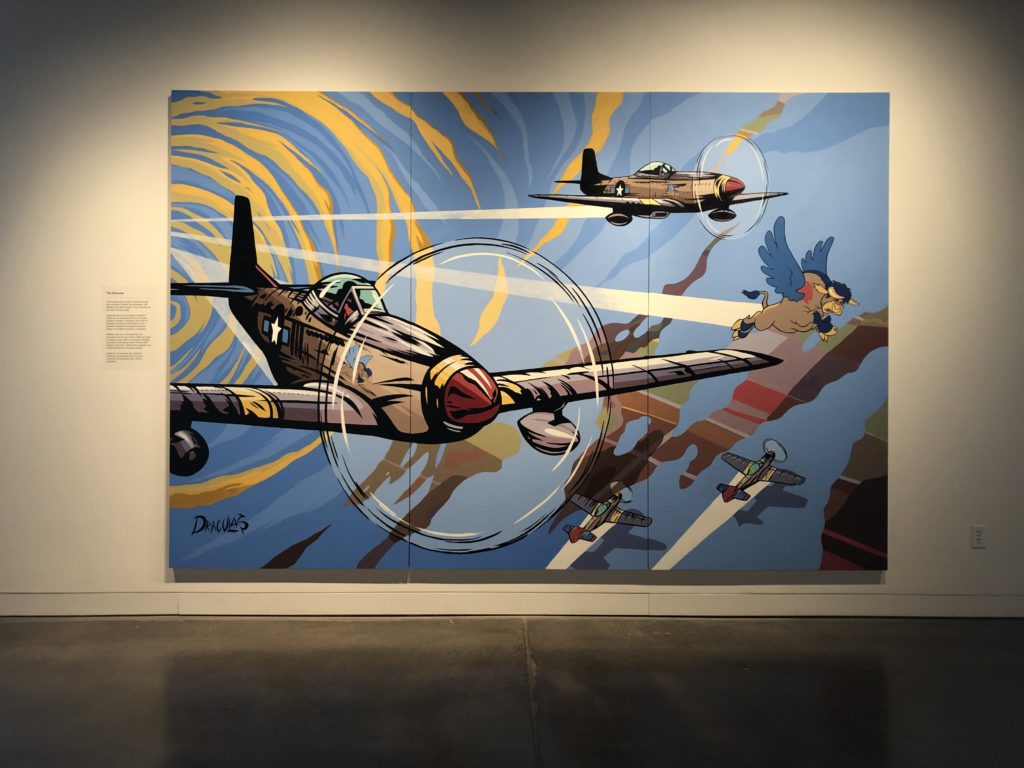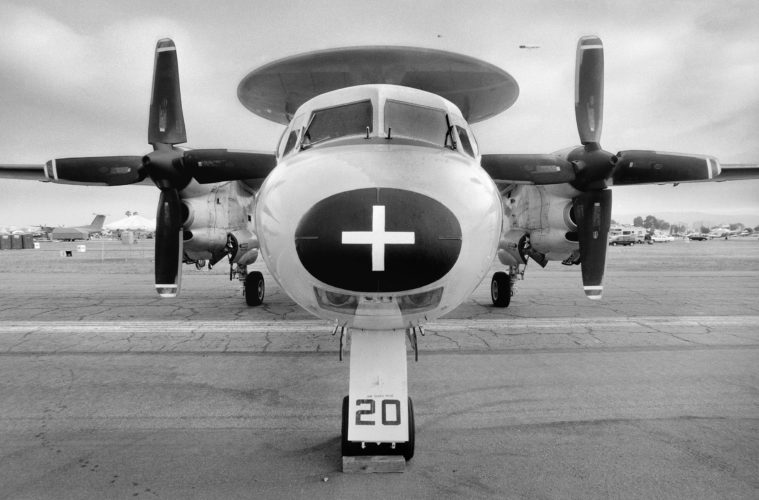The Great Park’s Palm Court Arts Complex, at the site of the former El Toro Marine Corps Air Station, is uniquely positioned to mount art shows extolling the glory and thrill of aviation.
The inaugural exhibition at the arts complex gallery, displayed in 2011, was “Plane Air Power: Paintings and Sculptures by Jorg Dubin.” With the title of the show — a play on the phrase “plein air painting,” meaning painting in the outdoors — Dubin created landscapes illustrating the former marine base’s runways, hangars and barracks, and two sculptures of F-18 fighter planes.
From July 2012 to March 2013, the Palm Court Gallery exhibited “Farmers to Flyers: Marine Corps Air Station El Toro and Mid-Century Orange County.” The show related in pictures, words, video and sculpture how O.C. grew in a century and a half from vegetable fields and citrus orchards to a Marine air base, and then to a bursting-at-the-seems megalopolis. The core of the exhibition was the development of MCAS El Toro (carved out of land originally owned by pioneer farmers). Along with accounts of military training and paraphernalia, there were portrayals of life on the base, as this city within a city was occupied by hundreds of thousands of marines and their families over decades.
From June to August 2017, the exhibition, “Walt and the Flying Bull” was based on the Disney studio’s design of the El Toro “Flying Bull” logo for the marine base. As delighted viewers to the show observed, Disney Productions created approximately 1,200 designs during World War II for American and Allied military units. The exhibition also included original designs by Marvel Entertainment, Pixar Animation Studios and several contemporary artists.
The current exhibition, “A Brief History of the El Toro Air Show: 1950-1997,” running through August 18, addresses aviation as patriotic performance art at the marine base, through painting and photography. Most works on display were created during the air show’s final years, concluding in 1997, and contemporaneously. Yet the annual El Toro Air Show began in 1950 to celebrate Armed Forces Day and to encourage people to visit the base. Attendance eventually reached 2 million.

The Draculas (Courtesy of the artist)
The largest image in the exhibition, an untitled mural at 12×8 feet, was designed in 2019 by Gary Musgrave, Jeff McMillan and Jake Kazakos. The artists collectively call themselves, “The Draculas,” as they work late into the night. Their mural features four World War II-era P-51 Mustang fighter planes, flying majestically through the air, surrounded by luminous blue skies, and accented by yellow stripes indicated jet streams. With Disney’s Flying Bull hovering among the bombers, the mural visually describes the dedication and intensity of fighting marines.
Nine paintings in watercolor, oil and ink by O.C.-based artist Paul Gavin were created during the last years of the El Toro Air Show. These stunning paintings, which were turned into posters, most in classic landscape style, capture the vistas, patriotism and drama of the air shows. Gavin’s 1989 painting, “Orange County Centennial,” depicts F-18 “Sharpshooter” planes on the tarmac, with long shadows and Saddleback Mountain in the distance.
Gavin’s 1990 “El Toro Winter” is a striking overview of the marine base, based on photos shot from a helicopter. Featuring the barracks, theater and water towers, nestled bucolically within fields, orchards and foothills, the painting evokes classic California impressionist paintings from the early 20th century. The artist’s 1991 “The Sound of Freedom,” created during the Operation Desert Storm invasion of Iraq, possesses the energy and patriotism typical of Normal Rockwell paintings. In Gavin’s artwork, throngs of onlookers wave their arms, motioning toward the majestic fighter planes in the air, while several people are hoisting American flags.

Paul Gavin – Marines A Tradition of Uncommon Valor – 1995 (Courtesy of the artist)
Along with paintings and posters from the subsequent years, 1992-94, Gavin’s final three works are the most dramatic. His 1995 “Marines: A Tradition of Uncommon Valor” celebrates the 50th anniversary of the 1945 landing of marines on Iwo Jima, as well as the photo “Raising the Flag on Iwo Jima” by photographer Joe Rosenthal. The painting displays an F-18 Hornet flying above air show spectators, while the outline of the Rosenthal photo is depicted as clouds in the far-off sky. Of all Gavin works in this show, “Uncommon Valor” is the most symbolic, as it looks back to a time when unusual bravery helped save our country.
The artist’s 1996 “Hail and Farewell” displays an F4U Corsair and F/A-18 Hornet flying over a landscape, with a sunrise and sunset as the backdrop. Along with flags and marine emblems festooning the sky, the work looks toward the marine’s impending departure from El Toro. Gavin’s final painting, the 1997 “A Stars & Stripes Salute,” a deftly designed collage of fighter planes, helicopters, flags, marines and an exploding bomb, bid farewell to the extraordinary era of the El Toro Marine Base.
Also in this exhibition are black and white photos of planes — the B-2 Spirit, the B-47 Stratojet, the F6F Hellcat, the F11 Tiger and the F4U Corsair — provided by U.S. Air Force, the National Naval Aviation Museum and the U.S. Navy. Completing this historic art show are several close-up black and white and color photographs, taken by George Katzenberg, during El Toro air shows. This body of work that the artist titles “Air Toons,” depicts various aircraft, including the B -25 Mitchell, the Hawkeye, the Nighthawk and the Warthog, as appearing to be less than six inches from the camera. His contribution to this show is as much an artistic sleight of hand as it is an illustration of various planes that were on display. Katzenberg explains that the lens used for the images covers a 94-degree view, and that it gives the effect that the aircraft’s tail, nose or weapon is comically exaggerated. His approach adds levity to the exhibition, perhaps expressing the human and empathetic side of the valiantly dedicated marines.
Great Park Gallery, Palm Court Art Complex, Orange County Great Park, Irvine; Thu. & Fri., noon-4 p.m., Sat. & Sun., 10 a.m.-4 p.m.; free. cityofirvine.org/orange-county-great-park/arts-exhibitions.
Advertising disclosure: We may receive compensation for some of the links in our stories. Thank you for supporting Irvine Weekly and our advertisers.

